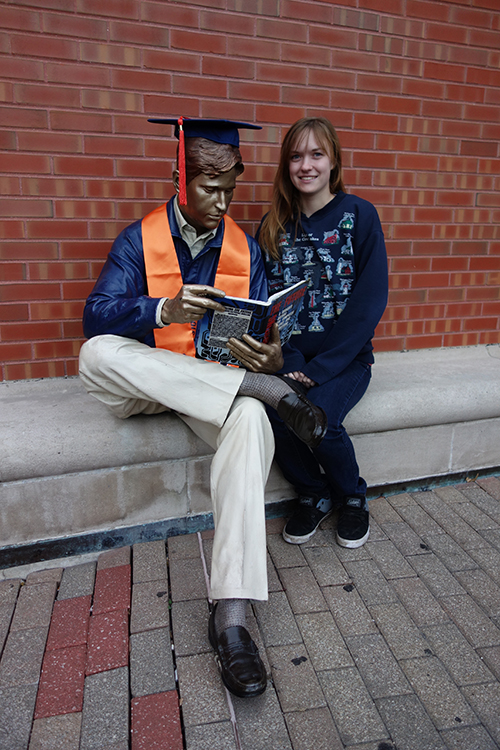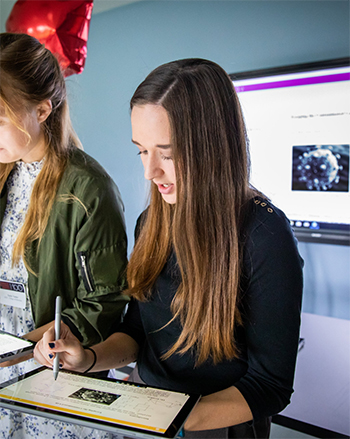Taylor Tucker Embraces Multidisciplinary Interests—Engineering and Engineering Education—While Researching Task Collaboration
June 7, 2021

Taylor Tucker. (Image courtesy of Taylor Tucker.)
When Taylor Tucker arrived at Illinois for a Bachelor’s degree in Engineering Mechanics, she was passionate about passionate about a number things, one of which was engineering. Then she met Education Associate Professor Emma Mercier and discovered something else—engineering education research. While pursuing this interest, she found another kindred spirit—ISE Teaching Assistant Professor Molly Goldstein, who's also passionate about engineering education. Now, two degrees later, and planning on tackling a third, Tucker is still passionate about and successfully pursuing both disciplines, has figured out a way to somehow combine the two, and is making a difference in both areas.
How’d Tucker get from engineering to engineering education? Part way through her undergrad course, she met Mercier whose research lab was studying engineering education for students in lower-level Theoretical and Applied Mechanics classes—the sort of classes Tucker had just finished. So, she joined Mercier’s group to help with data analysis, and ended up becoming very deeply involved.
“I used task design to work on improving how students collaborate in small groups in an engineering setting,” she says, explaining that many lower-level engineering courses have a lecture component and a discussion section where, typically, students are put into small groups of three to four to work on a task related to content from the lecture. Tucker’s work involved trying to improve how that task was designed and the way students work on it as a group. When the study first began, the researchers were seeing that even though the task had been given to the group, students ended up just solving it individually. Thus, they decided they needed a task that encouraged students to work together to solve it as a group. “How do we do this?” they asked themselves.
“That was the first step of the study,” Tucker explains, “then the follow-up question was, ‘Now that we’ve designed this task that’s supposed to get students to collaborate, how do we evaluate how effective it is?’ That’s where I joined.” Her first contribution was evaluating existing tasks. From there, she learned more ways to change the task’s design to further improve collaboration. “And that’s what led me into deeper work that culminated in pursuing a degree,” she continues.
Thus, now passionate about not just engineering, but also engineering education, after receiving her B.S. in engineering, she came back for a Master’s while continuing her engineering education research in Curriculum and Instruction (C&I) in the College of Education. Tucker just graduated on May 15th, 2021.

Taylor Tucker by Grainger Bob on campus.(Image courtesy of Taylor Tucker.)
Were they able to design a test that encouraged students to collaborate? “Yes,” she says. “We have seen success with the tasks, and what’s really cool is that over the course of the past five-ish years, I have witnessed students evolve as collaborative problem solvers in real time. It’s really rewarding to see just how they adapt to the different tasks and how the interactions among the group can change.” Admitting that it’s not perfect, and much more could be done, she adds, “Just being able to see real changes in a five-year span is amazing,” she acknowledges. “So, it’s been really cool to watch them and see how they grow as designers through this process.”
Tucker’s time at Illinois has been very interdisciplinary: first engineering, then a second degree in engineering education. And, no surprise, she’ll be back for a PhD—back to the technical side in academics. “The work has been very interdisciplinary,” she explains, “and that is such a rich environment to be in; so, I’ve been very grateful to have that experience, and I look forward to continuing along those lines.”
In other words, Tucker hopes to continue researching engineering education’s collaborative hands-on learning, which fascinates her, probably because of her background in it. “I see it becoming more normalized in engineering education,” she continues. In fact, her Master’s thesis looked at students working on a dissection task in small groups; they took a product apart to learn how it was engineered, modelled it in CAD, then made their own design improvements to it. “That helped me lay the foundation for what students experience when they collaborate on a hands-on task.”
Now that she’s been able to see what students are actually experiencing via this type of task, she wants to look at how to design these tasks to “play up the outcomes that we want, like the strong collaboration and getting all the students more equally involved in hands-on participation…So what I hope to do with my PhD research is to pursue this topic more deeply, supporting hands-on learning in engineering education and answering, ‘How do we design for this?’ But what may be really interesting to do is actually look at how practicing engineers in the field experience design— especially physical design, where they may be doing a hands-on teamwork component and what that actually looks like in the workplace.”
If Tucker knew that, she’d have a better idea contextually how engineering educators should be preparing students. So, her goal is to spend time in industry before she starts on her PhD. After determining how engineers collaborate during the design process, she hopes to look at how that compares to the experiential component engineering educators are actually using. “I think that will really guide my data for the PhD,” she adds.
Regarding Tucker’s hope to get all students equally involved in hands-on participation, she discusses group dynamics prevalent in any educational setting: some students are leaders who take charge, some students are the followers and doers, and then there are the withdrawn students who sit on the fringes, rarely contributing.
“There’s a lot of research out there on the different emergent roles that occur in a teamwork setting for various ages of students all across the spectrum,” Tucker explains. “I think these rules really do transcend where you are situated in education and what you’re studying. I see the same thing with engineers.” She thinks it’s more tied into the dynamics of teamwork, and that many factors influence that, even in a small group setting of three to four people.

Taylor Tucker participating in the BER Showcase in 2019. (Image courtesy of Taylor Tucker.)
“Everyone is looking at each other,” she continues. “They're going to size up where they fit, and typically someone will emerge as the leader. That emergent leadership will impact what the other students do; will they simply follow the leader, or try to carve out their own role?"” Explaining that the research out there looks at what’s happening and why it’s happening, in her own research, she’s definitely seen some of that emergent leadership. She’s also seen passive behavior—the student who is on the fringes watching the group, but maybe not making as many contributions of their own.
“I see a lot of different roles at play,” she acknowledges. “We do try to use the tasks assigned to mitigate some of these and bring everyone into a more equal contributory space; there are different ways that you can get at that: my focus has been with the design of the task itself to do it.”
Tucker saw that phenomenon in her thesis research as well. But what she found more interesting was the presence of the object and the fact that they now had to actually participate physically in the task.
“There were some different roles coming up that I had not seen on a task without the physical object, so it was cool to see these new, different ways that students interacted and how they behaved in a group setting with the object there versus when it was not there.”
So, when real engineers, experts in their fields who are confident in their roles collaborate in group settings, does the group dynamic take over in that group too?
“I really think it does,” Tucker claims, “and that’s why the more you can get experienced collaborating in a group early on, especially in school, I think, the better you are prepared.” She describes a scenario: someone well versed in working with diverse people, who has experienced those different roles and observed how some people emerge in the leadership and others don’t, and has developed their own strategies, tellsthemselves: “‘When I approach the group, this is what I want to do, and this is how I want to act,’ whereas somebody who has not had that much experience would not have any of those strategies. It would be more the experience of going in blind and hoping for the best.”
“I want to see students, particularly in engineering, really get that experience early on so they can go out in the workforce prepared to work with diverse people in their field, which is exactly what happens.” She says real-world engineers not only collaborate with other engineers, but they need to draw on experts from all sorts of fields. “Because you need all the input you can get when you’re making a complex design, and you need to know who your audience is, the real-world context of this, how it’s going to work in its environment, and you may not know that as well as somebody who is in that environment would, so you better work with them. So, the more that you can get this experience in school, I think, the better for you.”
So, what are Tucker’s plans for the immediate future? After taking a year off to work outside of academia, beginning in fall 2022, she’ll be pursuing a PhD in Industrial & Enterprise Systems Engineering (ISE) at Illinois. "I want to go back to the technical side to get to practice more my engineering skills,” Tucker says, “because, ultimately, I do want to end up in industry. But I have found avenues through which I can still have my engineering education focus in my research, and I was very blessed that by being able to work with Molly Goldstein and others in that department, I am able to keep focusing on that sort of work, even though I’m back on the more technical side.”

Jenny Saves a Convertible the book Taylor Tucker wrote, which was recently published. (Image courtesy of Taylor Tucker.)
ISE Teaching Assistant Professor Molly Goldstein, whom Tucker has been working closely with, is going to be Tucker’s advisor for the PhD. Tucker wanted to be sure to credit people like Mercier and Goldstein and the industrial engineering people she worked with throughout this process. ‘I really got my start in research through Emma, joining her lab and then having Molly co-advise me on my thesis,” she explains, adding that when she was observing the students working on the dissection tasks, she was actually observing students in one of Goldstein’s classes.
“So she let me come into the classroom for that,” Tucker adds. “It’s so impactful to the experience to be able to work with such strong people and learn from their perspectives and their visions, so I really appreciated getting to work with them and so many others,” Tucker says.
On another note, in her spare time, Tucker is making a life-long dream a reality—writing children’s books. She just published her first, called Jenny Saves a Convertible, which is actually available now on Amazon, and is working on a second.
Story and photos by Elizabeth Innes, Communications Specialist, I-STEM Education Initiative
For another I-STEM article about Taylor Tucker, see:
- Convertibles and Thunderstorms—Children’s-Book-Writing Duo on Their Way Thanks to Illinois Training and Encouragement from Mentors
More: Engineering, MechSE, Illinois Legacies, Women in STEM, 2021













.jpg)
















